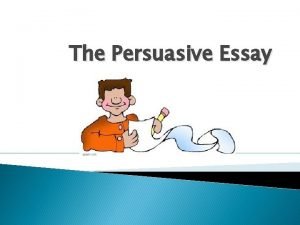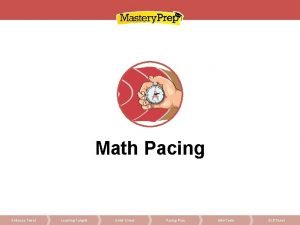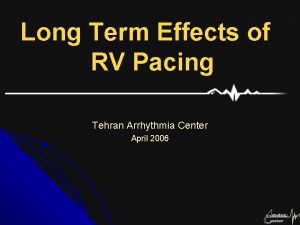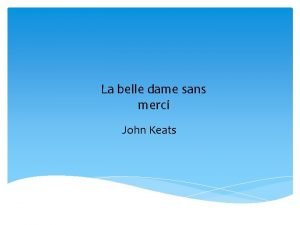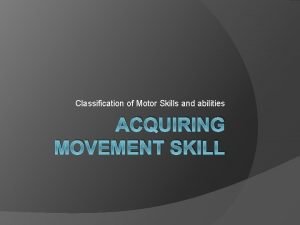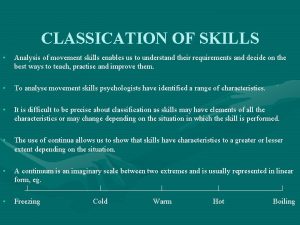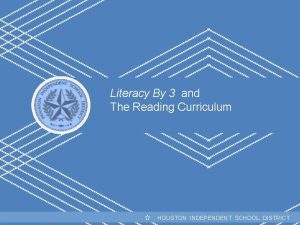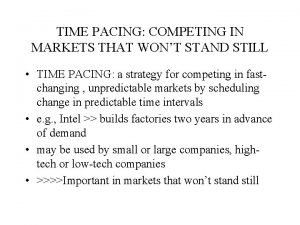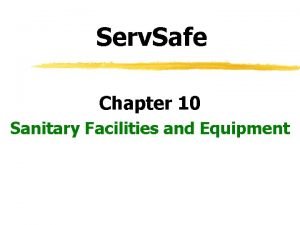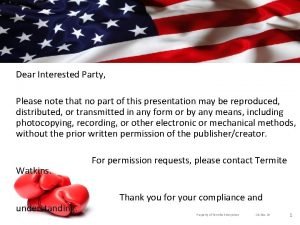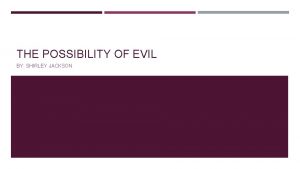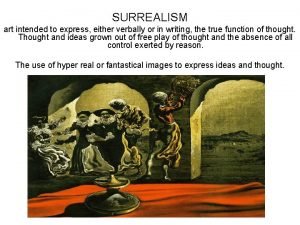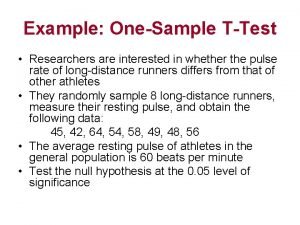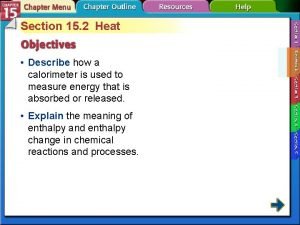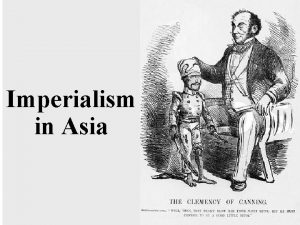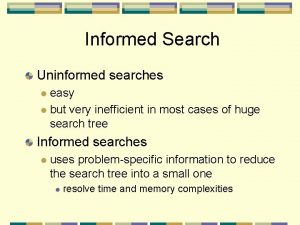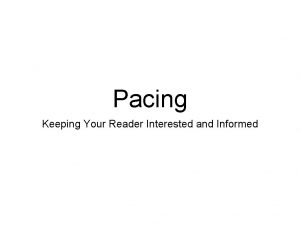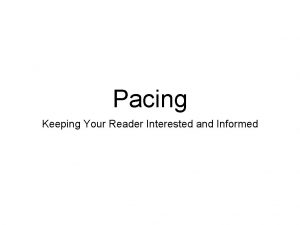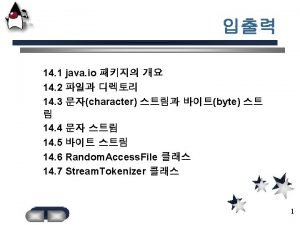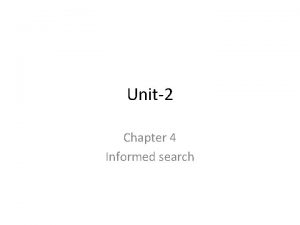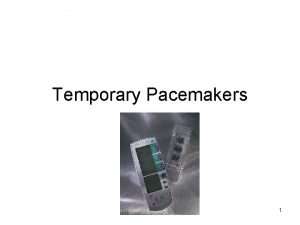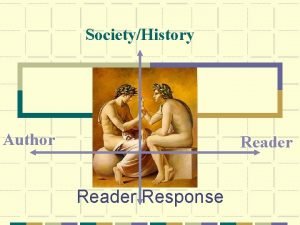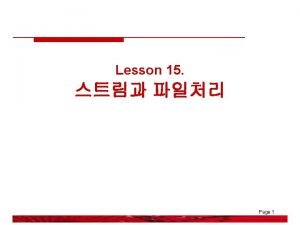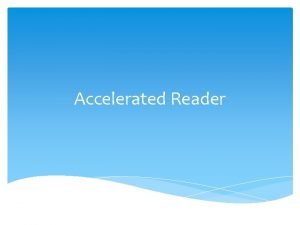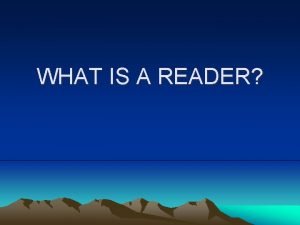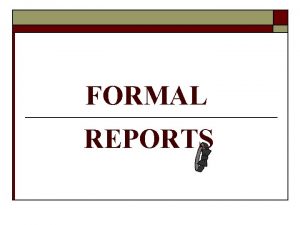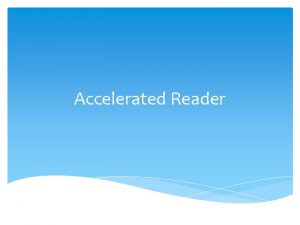Pacing Keeping Your Reader Interested and Informed English




































- Slides: 36

Pacing Keeping Your Reader Interested and Informed

English IV Honors Today you will need a pen, paper, and your Angela’s Ashes book. As you write your next vignettes, try to incorporate elements from the writing style lessons to enhance your vignettes. By the end of the unit, we will discuss: pacing, snapshots, thoughtshots, and exploding a moment.

What Is Pacing? A writer’s way of manipulating time and details to keep the reader interested in the story ØThis prevents the reader from • being bored by unimportant details • being confused by too many details • being overwhelmed by a story that spans a long period of time

Pacing Techniques • For Important Details. . . • • • describe very important people/events/ideas with specific details (using Snapshots and Thoughtshots would be helpful) turn important “telling” sentences into “showing” sentences (using Snapshots) use dialogue with speaker tags when the conversation is important use Exploding Moments--describing very important things in such small detail as to make it appear to happen in slow motion use short sentences to build suspense or to create a hurried mood for your reader--at times when events are happening quickly or when emotions are intense use longer sentences to draw out details or to create a relaxed, calmer mood for your reader--at times when events are happening slowly or when emotions are more tranquil

Pacing Techniques • For Unimportant Details. . . • • • omit unimportant information describe less important people/events/ideas in only a few details (use “telling” sentences rather than “showing” sentences) summarize or omit unimportant conversations do not write a story that spans a long period of time (like days, weeks, or months); choose ONE time period for the story and use Flashbacks to show very important information that occurs BEFORE the time period of the story use Flash Forwards--skip parts in time when nothing important happens

A Word of Caution • BE CAREFUL--balance details carefully. Too many details OR too little action can drag on and get boring. Too few details feels rushed and confusing.

Adding Snapshots: How to “Show, Not Tell” in Writing � 1. Action Words = Strong verbs ◦ Examples: �Instead of run, use jogged, sprinted, bolted �Instead of said, use whispered, shouted, exclaimed 7

Adding Snapshots: How to “Show, Not Tell” in Writing Sensory Details = Strong Adjectives and Descriptions � 2. �Sight – describe what you see, color, size �Sound – boom, bang, buzz, �Smell – musty, rotten, fresh �Taste – sweet, salty, sour �Touch – fuzzy, prickly, squishy 8

Adding Snapshots: How to “Show, Not Tell” in Writing Dialogue--Let Characters Speak for Themselves � 3. �Telling: ◦ Lindsey and Chelsea were really excited about the concert. Lindsey said she couldn’t wait, and Chelsea agreed that it would be fun. ◦**Here, the WRITER is telling us--summarizing for us--how Lindsey and Chelsea feel. �Showing: ◦ “I can’t believe it’s here! I’ve been waiting for this concert for weeks, ” Lindsay shouted from her room as she was getting dressed. ◦ “I know! It’s going to be a blast!” exclaimed Chelsea, while she patiently waited for Lindsay to finish getting ready. ◦**Here, the writer lets the CHARACTERS talk 9

How to “Show, Not Tell” in Writing Snapshot – a specific description of an important detail in the story that creates a picture for the readers to see in their minds and experience it through writing. � 4. � Snapshots SHOW, and don’t TELL. � Snapshots use SENSORY DETAILS 10

Example �“Telling” ◦ Ryan was tired. �“Showing” ◦ After a long day of school followed by a 2 hour football practice, Ryan trudged back to his dorm. His eyelids drooped, and he struggled to keep them open. His backpack felt as if it were full of huge rocks. Ignoring the piles of clothes on the floor and the mountain of homework on his desk, he dropped his backpack on the floor with a BOOM. He flopped onto his soft bed, wrapped the warm blankets around his exhausted body, and closed his eyes. 11

Example �“Telling” ◦ Ryan was tired. Strong Verbs in RED Sensory Details in BLUE �“Showing” ◦ After a long day of school followed by a 2 hour football practice, Ryan trudged back to his dorm. His eyelids drooped, and he struggled to keep them open. His backpack felt as if it were full of huge rocks. Ignoring the piles of wrinkled clothes on the floor and the mountain of homework on his desk, he tossed his backpack on the floor with a BOOM. He flopped onto his soft bed, wrapped the warm blankets around his exhausted body, and closed his eyes. 12

Practice �Use the “telling” sentence for your row to “show” the situation. Use action words, sensory language, dialogue, and/or snapshots in your writing. �Row 1: I am nervous. �Row 2: This weather is nice. �Row 3: Dinner was delicious. �Row 4: Lauren is scared. �Row 5: The ocean is beautiful. 13

Thoughtshots

• There is a time in writing when it’s necessary to go into the thoughts of how you feel, what you’re thinking, dreaming, imagining, etc. • These are called “thoughtshots. ” • In a thoughtshot, you let your reader see what’s going on in the head of your characters (or yourself, if the story is about you).

Types of Thoughtshots – Flashback Thoughtshot: a character thinks back about something that has already happened. • EX: “He remembered the first time he saw the snow. . . ” - Flash-Forward Thoughtshot: a character thinks about what is going to happen or what might happen in the future. Writers often use Flash-Forwards when a character is trying to make a decision. • EX: “She thought about going to the new school. What would it be like? Would she have friends? ” - Internal Monologue: a character thinks about what he/she is experiencing or feeling at that moment. • EX: “He thought about what the teacher had just said. His mind raced, but he didn’t know the answer. Why did she call on him? What would the other kids think if he didn’t give a correct answer? ”

Examples of Thoughtshots – Flashback Thoughtshot: a character thinks back about something that has already happened. • From “Little Red Riding Hood” –The wolf went up to Little Red Riding Hood and told her that he knew a shortcut. Little Red Riding Hood thought back to what her mother told her about not talking to any strangers and watching out for the wolf in the woods. But it was too late; she had already listened to the wolf’s directions.

Examples of Thoughtshots - Flash-Forward Thoughtshot: a character thinks about what is going to happen or what might happen in the future. Writers often use Flash-Forwards when a character is trying to make a decision. • From “The Daydreamer”-- I will buy a meal with the first coin, thought the man excitedly. With the second coin, I will gain some chickens. These chickens will grow and multiply, and I will soon have eggs. I can then sell eggs to buy some goats! As the second man walked along the dirt path, he began to imagine his very own herd of goats. I can then sell some goats to buy cows, and as the cows breed, I can sell those, as well! Soon I will have enough money to buy my own land. . . and I will marry. . . and have my own family. . . who will help me in the fields. . . and the land will give me everything I need!

Examples of Thoughtshots - Internal Monologue: a character thinks about what he/she is experiencing or feeling at that moment. • From “Nightmare in Blue” – It must be a cramp, George thought frantically; he’d seen Tommy swim several times that distance. For a second he almost flung himself into the water, but then he told himself: It won’t help him for me to drown with him and if I can get Wilma there’s at least a chance….

Using Thoughtshots • Look at your own writing piece. • Ask yourself the following. . . –Does the reader know the thoughts that went through my head during my experience? –Does the reader know how I’ve grown as a result of the experience? –Does the reader see who I really am as a result of my thoughtshot? • Look at the 3 kinds of thoughtshots. What types of thoughtshots would be most appropriate to help the reader understand the purpose of your story?

Off you go!! • Using the New Thoughtshots handout, add OR revise thoughtshots in your story. Each page of your narrative needs AT LEAST 2. • ADD thoughtshots if the paragraph doesn’t have any. • REVISE the thoughtshots if the ones you have written are INEFFECTIVE or MINIMAL.

Exploding Moments Using Snapshots and Thoughtshots to Explode the Moment

Exploding the Moment o. What is it? n When a moment is slowed waaaay down for the purpose of painting a frame-by-frame picture for your reader… n Uses Snapshots n Uses Thoughtshots o Flashbacks o Flashforwards o Internal Monologue n Uses Baby Steps (a series of descriptions of tiny moments in a larger event)

Sample Sentence o Take the sentence “He walked through the doorway. ” This doesn’t have much detail. It goes by very fast for the reader and doesn’t show anything important. o Now let’s explode that moment. 24 24

Describe the action in slow motion. He grasped the doorknob and turned it slowly to the right. He pushed the door inward. He darted his eyes to the right. Nothing. He pushed the door open a little farther, and slowly moved his right foot into the room.

Add Snapshots. . He grasped the cold doorknob and turned it slowly to the right. He pushed the door inward. The hinges squeaked and cold air rushed past the opening door. The room was dark. He darted his eyes to the right. Nothing. He pushed the door open a little farther, and slowly moved his right foot into the room. His shoe creaked a bit as it hit the polished hardwood floor.

Add Thoughtshots. . He grasped the cold doorknob and turned it slowly to the right. He pushed the door inward. The hinges squeaked and cold air rushed past the opening door. The room was dark. He darted his eyes to the right. Nothing. He pushed the door open a little farther, and slowly moved his right foot into the room. His shoe creaked a bit as it hit the polished hardwood floor. What am I doing here? he wondered. He began to wish he’d never accepted that dare.

How Do You Feel About. . o. Look at the sentence n“I poured milk on my sister’s head. ” o. What do you see in your mind? o. What is the writer thinking during this event? o. What questions do you have for the reader?

Exploding the Moment o. Using EXPLODING MOMENTS, “I poured milk on my sister’s head” becomes. .

A FABULOUS Exploded Moment o I watched myself begin this horrible deed. My hand seemed to suddenly have a will of its own. It picked up the milk carton. The spout was already open. My arm extended over Carol’s head, tipping the carton. The liquid poured in slow, steady thick unending streams down through her long, blonde hair, soaking the back of her clothes and running onto the floor. As the milk reached the floor I shifted the spout slightly to begin another long milky journey down the front of her. It poured over her forehead, in the eyes, running in rivers down each side of her nose, converging on the chin and splashing into her pate. Her food was soon awash and the milk poured over the edge, and ran into her lap. And still I poured on--it was too late to stop now. The rapture of it all. Oh, sweet revenge. 30 30

A FABULOUS Exploded Moment o Carol was shocked into absolute silence, her milkwashed eyes staring at me in total disbelief--almost uncomprehending. What had I done? I only meant to pour a little to scare her, and now it was all over-everywhere. Her chair was a four-legged island in the middle of a giant white pond in the kitchen floor. How could one quart of milk go so far? For a second or two, she didn’t react and I had a brief but fleeting prayer that she was stunned speechless. However, not for long. o “Dadddeeeee!” she screamed at the top of her lungs. The sound of glasses being knocked over the coffee table in the living room and my father charging around the corner happened simultaneously. In an instant he took in the whole scene. Horrible big sister 31 31 pours milk over innocent little sister’s head. I simply

Look at the techniques used o. Snapshots in RED o. Thoughtshots in BLUE 32 32

A FABULOUS Exploded Moment o I watched myself begin this horrible deed. My hand seemed to suddenly have a will of its own. It picked up the milk carton. The spout was already open. My arm extended over Carol’s head, tipping the carton. The liquid poured in slow, steady thick unending streams down through her long, blonde hair, soaking the back of her clothes and running onto the floor. As the milk reached the floor I shifted the spout slightly to begin another long milky journey down the front of her. It poured over her forehead, in the eyes, running in rivers down each side of her nose, converging on the chin and splashing into her pate. Her food was soon awash and the milk poured over the edge, and ran into her lap. And still I poured on--it was too late to stop now. The rapture of it all. Oh, sweet revenge. 33 33

A FABULOUS Exploded Moment o Carol was shocked into absolute silence, her milkwashed eyes staring at me in total disbelief--almost uncomprehending. What had I done? I only meant to pour a little to scare her, and now it was all over-everywhere. Her chair was a four-legged island in the middle of a giant white pond in the kitchen floor. How could one quart of milk go so far? For a second or two, she didn’t react and I had a brief but fleeting prayer that she was stunned speechless. However, not for long. o “Dadddeeeee!” she screamed at the top of her lungs. The sound of glasses being knocked over the coffee table in the living room and my father charging around the corner happened simultaneously. In an instant he took in the whole scene. Horrible big sister 34 34 pours milk over innocent little sister’s head. I simply

Now It’s Your Turn. . o. Find the MOST IMPORTANT event in the story you wrote for your vignette o. Use BABY STEPS to put the action in SLOW MOTION o. Use SNAPSHOTS to add descriptions about the five senses to SHOW and not TELL o. Use THOUGHTSHOTS to show what characters are thinking o. Record this on your Exploding Moments Handout 35 35

Exploding the Moment Review o. Select a sentence o. Explode that sentence by. . . o. Break the action down into a series of tiny mini-actions (baby steps) o. Providing your reader with a frame-byframe picture of the action (details through snapshots) o. Provide your reader with insights into the character’s thoughts (details through thoughtshots)
 Keeping your hands clean and dry persuasive essay
Keeping your hands clean and dry persuasive essay Pacing and pausing
Pacing and pausing Lesson structure and pacing
Lesson structure and pacing Consider a football coach pacing back and forth
Consider a football coach pacing back and forth Keeping your career on track
Keeping your career on track Ecg lead placement
Ecg lead placement Quick check math
Quick check math Aai pacing
Aai pacing Merci poque
Merci poque Transvenous pacing
Transvenous pacing Pacing
Pacing Classify the
Classify the Muscular involvement continuum
Muscular involvement continuum Hisd curriculum scope and sequence
Hisd curriculum scope and sequence Event pacing
Event pacing Flink
Flink Pacing formula(surveying)
Pacing formula(surveying) Internal and external issues template
Internal and external issues template Servsafe cutting board colors
Servsafe cutting board colors Dear interested
Dear interested The possibility of evil questions
The possibility of evil questions What is the difference between 29 028 and 1 312
What is the difference between 29 028 and 1 312 Rene magritte the red model
Rene magritte the red model Gerund and infinitive forms
Gerund and infinitive forms Difference between independent and one sample t test
Difference between independent and one sample t test Trait theories
Trait theories Why are chemists interested in studying thermochemistry?
Why are chemists interested in studying thermochemistry? Psychologists have long
Psychologists have long I have long been interested
I have long been interested Population ecologists are primarily interested in
Population ecologists are primarily interested in Mayan customs
Mayan customs Free prior and informed consent
Free prior and informed consent Informed and uninformed search in artificial intelligence
Informed and uninformed search in artificial intelligence Uninformed search
Uninformed search Informed and uninformed search
Informed and uninformed search Give us your hungry your tired your poor
Give us your hungry your tired your poor Keeping an infant safe and well section 7-3
Keeping an infant safe and well section 7-3
